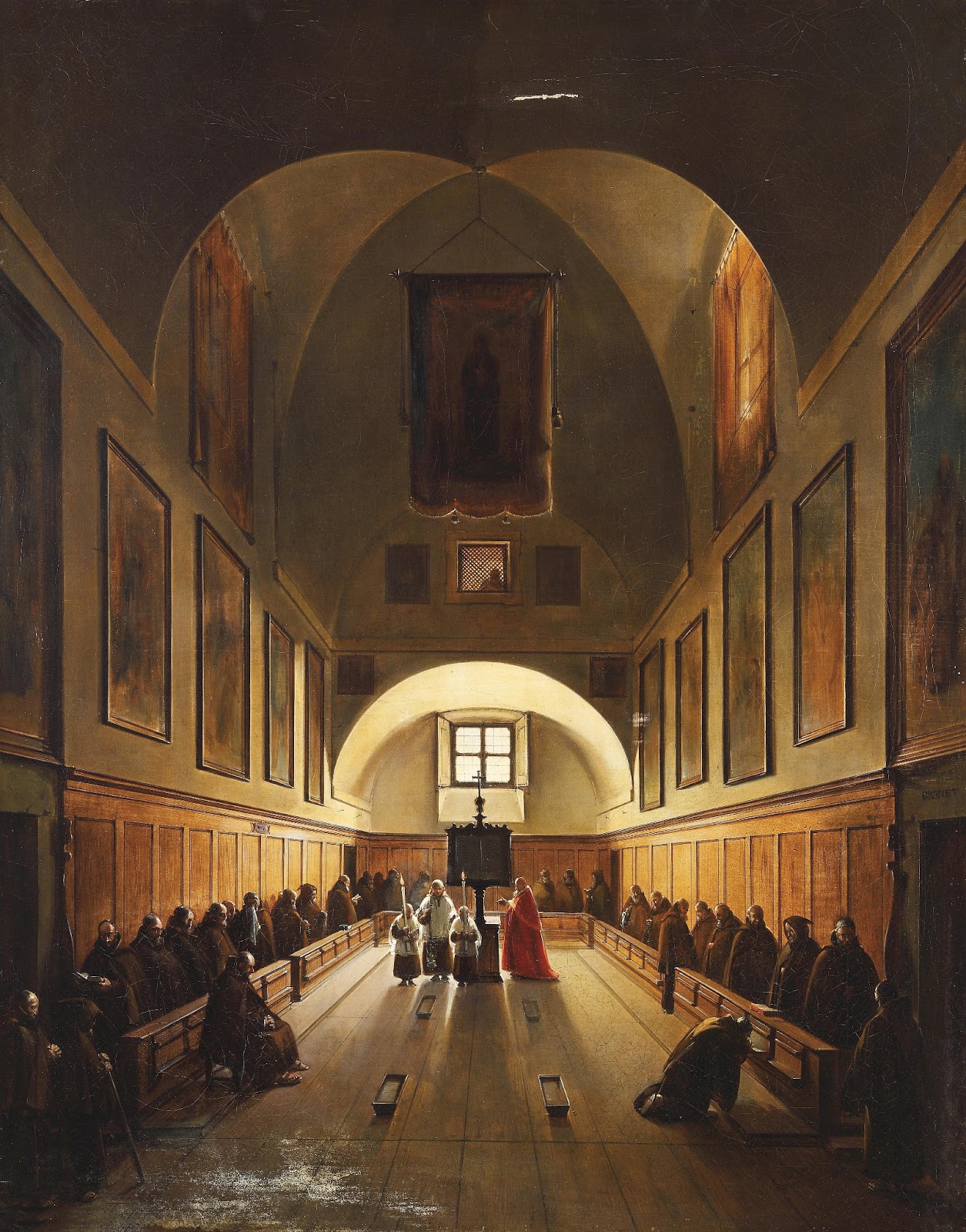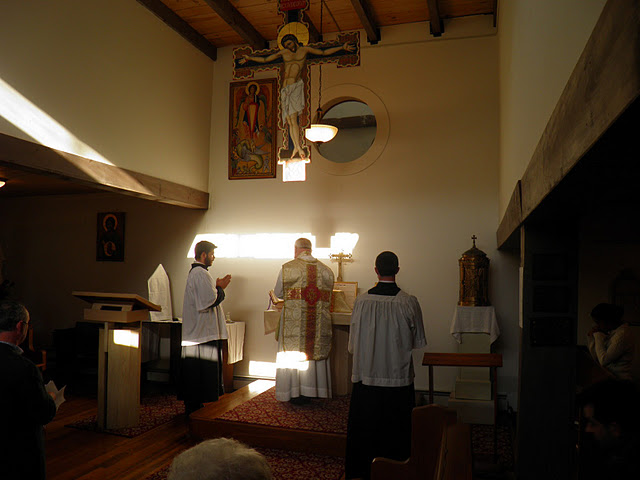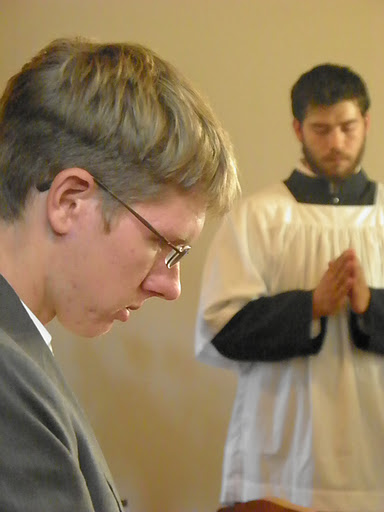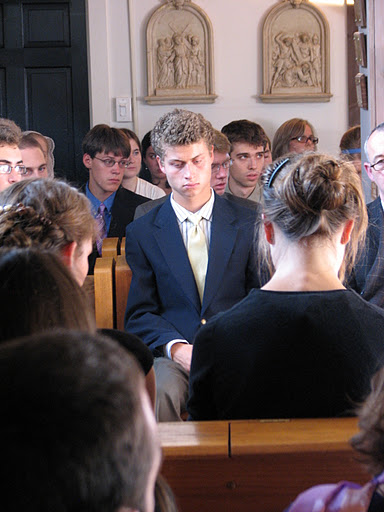This is an excellent resource for those wishing to pray the Office at home.
Universalis.com Now Has Pointed Psalms - You Can Sing the Office At Home Using Your Smartphone
How to Compose Psalm Tones for the Vernacular - Have a Go Yourself
 Here's an article that I wrote and was first posted on the traditional music website, Corpus Christi Watershed. It is about the principles used when creating psalm tones for the vernacular. It explains the method by which the tones that are given on this site were developed at Thomas More College and how we tried to incorporate the principles of tradition when adapting tones from the old English Sarum Rite written originally for the Latin to the English. Read the full article here.
I always maintain that to be vital, every tradition must always have new forms that encapsulate its essential elements, but speak anew to each successive generation. This means that we cannot simply look at the past in regard to sacred music. We must also compose. If we don't the tradition will die again. So, in accord with that I say if you don't like what I have done then please think about creating something that you do like!
Here's an article that I wrote and was first posted on the traditional music website, Corpus Christi Watershed. It is about the principles used when creating psalm tones for the vernacular. It explains the method by which the tones that are given on this site were developed at Thomas More College and how we tried to incorporate the principles of tradition when adapting tones from the old English Sarum Rite written originally for the Latin to the English. Read the full article here.
I always maintain that to be vital, every tradition must always have new forms that encapsulate its essential elements, but speak anew to each successive generation. This means that we cannot simply look at the past in regard to sacred music. We must also compose. If we don't the tradition will die again. So, in accord with that I say if you don't like what I have done then please think about creating something that you do like!
The painting, by the way, is from 1808 by the French artist Granet of the choir singing in the Capuchin church in Rome.
Has Pope Francis Saved Western Culture?
 One small change to the wording of the mission of the Anglican Ordinariate, instituted by Pope Francis might have a profound effect on how it participates in the Church's mission of evangelisation; and on English speaking culture.
When I was at the Sacra Liturgia Conference this past summer, speaker after speaker emphasised the importance of Latin as the norm in the Roman rite. Nevertheless, a warm welcome was given also to several priests from the Anglican Ordinariate, which will rarely offer Mass in Latin, and it was offered the platform when Mgr Keith Newton gave a talk in which he described progress in establishing the precise form of the Ordinariate liturgy. I heard no one say that they saw any contradiction in this. Similarly, the developments in the Ordinariate Use liturgy are, apparently enthusiastically, reported on this site as they occur and have been ever since it was created. The fact that the Ordinariate Use is taken seriously by all these traditionally minded Latin-orientated Catholics seems to me to indicate a recognition of the general point, that the vernacular does have an important place in the liturgy; and more particularly that English has a privileged position amongst vernaculars. Where might this be going in the future, I wondered?
One small change to the wording of the mission of the Anglican Ordinariate, instituted by Pope Francis might have a profound effect on how it participates in the Church's mission of evangelisation; and on English speaking culture.
When I was at the Sacra Liturgia Conference this past summer, speaker after speaker emphasised the importance of Latin as the norm in the Roman rite. Nevertheless, a warm welcome was given also to several priests from the Anglican Ordinariate, which will rarely offer Mass in Latin, and it was offered the platform when Mgr Keith Newton gave a talk in which he described progress in establishing the precise form of the Ordinariate liturgy. I heard no one say that they saw any contradiction in this. Similarly, the developments in the Ordinariate Use liturgy are, apparently enthusiastically, reported on this site as they occur and have been ever since it was created. The fact that the Ordinariate Use is taken seriously by all these traditionally minded Latin-orientated Catholics seems to me to indicate a recognition of the general point, that the vernacular does have an important place in the liturgy; and more particularly that English has a privileged position amongst vernaculars. Where might this be going in the future, I wondered?
Then shortly after returning from Rome I read in Damian Thompson's blog in the Telegraph an article that was headed Pope Francis Embraces the Ordinariate and Increases Its Power to Evangelise. In it he said: 'Francis has widened the remit of the Ordinariates in Britain, America and Australia. Until now, only ex-Anglicans and their family members could join the new body. But, thanks to a new paragraph inserted into the Ordinariate's constitution by Francis, nominal Catholics who were baptised but not confirmed can join the structure. Indeed, the Holy Father wants the Ordinariates to go out and evangelise such people.'
The paragraph he referred to was Complementary Norms, Article 5 §2: 'A person who has been baptised in the Catholic Church but who has not completed the Sacraments of Initiation, and subsequently returns to the faith and practice of the Church as a result of the evangelising mission of the Ordinariate, may be admitted to membership in the Ordinariate and receive the Sacrament of Confirmation or the Sacrament of the Eucharist or both. This confirms the place of the Personal Ordinariates within the mission of the wider Catholic Church, not simply as a jurisdiction for those from the Anglican tradition, but as a contributor to the urgent work of the New Evangelisation. As noted by the Congregation for the Doctrine of the Faith, enrolment into a Personal Ordinariate remains linked to an objective criterion of incomplete initiation (i.e. baptism, eucharist, or confirmation are lacking), meaning that Catholics may not become members of a Personal Ordinariate for purely subjective motives or personal preference.’
I have no special inside knowledge on the Ordinariate or the intentions for it. But I am struck by the potential for a profound affect on the wider culture globally for the good of what has happened recently. This is because of the relationship between liturgy and culture. Again, at Sacra Liturgia 2013, many speakers echoing Pope Benedict in the Spirit of the Liturgy, emphasised the connection between liturgy and culture. We were told for example, that an education in art, architecture, music and literature was necessary for the development of one's 'liturgical instincts'. The forms of the culture that we should study, therefore, are those that point us to liturgical forms (Catholic educators take note!); and those liturgical forms ought to be a 'liturgical high culture' - elevated cultural forms that draw us upwards but are nevertheless accessible and easily grasped.
The connection between the liturgy and culture is profound. Man is made to worship God; his worship is what establishes and shapes that relationship with God; and this, in turn influences all our human interactions and is the most significant factor in contributing to the grace and beauty of our actions and interactions. The culture might be viewed as the aggregate, the vector sum of these and is a reflection of - or incarnation of - our core values, priorities and beliefs.
While this connection can be conceived as a symbiotic dynamic, with each - liturgy and culture -simultaneously reflecting and nourishing the other, the relationship between the two is not a partnership of equals. The liturgy is a more powerful influence on the culture than the culture is on the liturgy. So in consideration of a reform of the culture, we should always look to ourselves first and strive for liturgical orthodoxy and purity. Accordingly we should strive to have liturgical culture high culture that is noble and naturally accessible. This is a culture that it makes high demands of those who create these forms - the writers, artists, composers and architects - but never of those who see it and hear it. It should touch people and then draw them upwards through the beauty of its forms, in harmony with worship. This accessible divine beauty can touch the soul in a way 'beyond words' (I'm thinking of St Augustine here).
In his book on the liturgy published first in 1918, the Spirit of the Liturgy, Romano Guardini tells us that liturgical forms are necessarily reflective of a high culture: 'Culture enables religion to express itself and helps distinguish the essential from the non-essential...as a rule, the spiritual life should be impregnated with a genuine and lofty culture... If the cultural element of prayer declines, the ideas become impoverished, the language coarse, the imagery clumsy and monotonous and the emotional paltry and artificial.' (p34)
He also describes the influence in the other direction, that the appropriate forms in the liturgy inspire and sustain a vibrant and beautiful contemporary culture: "The liturgy possesses a tremendously compelling form of expression, which is a school of religious training and development to the Catholic who rightly understands it and which is bound to appear to the impartial observer as a cultural formation of the most lofty and elevated kind." (p47; pub Herder and Herder).
Historically, if we look at the art, music and architecture we can see how the liturgical forms have influenced the culture. The baroque of the 17th century, for example, started off as part of the renewal of the Catholic counter-reformation and then the liturgical forms became the models in style for the profane (as in not explicitly sacred) forms as well.. So powerfully striking and beautiful was the wider culture created by this, that it became the standard throughout Europe, even in the protestant lands, for example, the Netherlands and England. The public buildings, the portraits and landscapes of their artists and even the music took inspiration from the Catholic liturgical culture.
The effect can be negative as well. If the liturgy is not beautiful and the cultural forms that are associated with it are deliberately made to take their inspiration from the wider secular culture that is not derived from liturgical forms, then a downward spiral is created in which the culture of faith and contemporary culture in turn cause the decline of the other. This is what we have seen most strikingly in modern times, accelerating in the 20th century (although the signs were there before that).
Catholics cannot ignore this question of contemporary culture. Even if we imagine a situation in which you have healthy and beautiful liturgical culture and that is also somehow disconnected from the wider culture and stable (a situation I can't imagine would ever be the case) we would still have a duty to try to transform the contemporary culture into one that reflected this liturgical culture. This is because those who do not go to church will not see the liturgy, which is our most powerful tool in evangelisation. But they do see the wider contemporary culture every day of their lives. If the wider culture reflects the beauty of the cosmos nourished by the liturgy, then its power will draw people to God and to His Church and provoke a curiosity and receptivity to the Word. This is the message of recent Popes in emphasising the power of beauty (for example Pope Benedict in his discussion of the via pulchritundinis). This is why incidentally, on a blog about liturgy, I consider it relevant to consider how this connects with secular culture - in my opinion we must not separate the two.
And what of the Ordinariate Use liturgy? Latin liturgy can stimulate a beautiful Catholic culture in any language of course but, I believe, the opening up of the traditional Anglican forms adapted for use in the Ordinariate supports this in a new and powerful way. The Anglican Ordinariate has elevated liturgical forms that do not look to modern secular culture for inspiration (unlike many of those in other vernacular liturgies), but rather, to the authentic Roman Church tradition and English high culture of the past. Therefore it can act powerfully to evangelise the culture of English speakers.
Why the special focus on English? I suggest that the influence of English in the world is great and is steadily increasing and hand in hand with this is English speaking culture, for good or ill. One might say that English is the lingua vulgata - the common language - of our age, and who knows for how long afterwards, perhaps centuries. It is the second most spoken (after Mandarin) as a first language and if you take second languages into account the gap is narrowed and getting narrower, for English is the international language of business and technology. This was emphasised to me recently when listening to Venezuelan radio and a discussion in Spanish (translated by my wife) about the fact that English is beginning to influence the way that Spanish is spoken by the general population as it incorporates its vocabulary and idioms.
It therefore becomes vital that we evangelise Western culture which is spreading globally, and a liturgy rooted in English language is a powerful means of doing this. Now that the Ordinariate Use is free to reach out beyond former Anglicans this can be at the centre of this. It might not be only through direct effect - one could envisage the situation where it's forms might also have an impact on the Roman Rite in English which is the not Ordinariate Use. At Thomas More College of Liberal Arts, where I teach, we regularly have the Extraordinary Form, and the Ordinary Form in English and Latin. We also sing the Liturgy of the Hours daily, with the psalms most commonly sung in English. For our vernacular liturgies we look to these Anglican forms of music and prayer in our vernacular liturgy for inspiration, even though it is not Ordinariate Use.
Incidentally I have heard some argue openly that they do not like to see a well done vernacular, or even Latin Novus Ordo, because they feel that the worse the alternatives are, the more likely it is that the Extraordinary Form will dominate. I do not accept this approach at all. In my mind, we should strive to make our participation in all liturgy (vernacular or not, Ordinariate Use of not) dignified and beautiful; in my mind this supports rather than diminishes the re-establishment of Latin in the liturgy in such a way that participation is active (in the proper sense of the word).
If we are to evangelise the English speaking world, which increasingly means the whole world, in a powerful way it could be a through a contemporary culture of the English. This contemporary culture could develop powerfully out of a beautiful English language liturgy that points to that of Shakespeare and Donne; and musical forms that are derived from the pre-reformation Sarum Liturgy. I would hope to see a flourishing of creativity inspired by this in which noble and accessible forms of both liturgical and contemporary culture are produced (in the way the Shakespeare was the popular culture of his day). It seems possible to me that the Anglican Ordinariate could be a force the good in this area.
The Thomas More College approach to Music in the Liturgy
 The choir at Thomas More College of Liberal Arts is busy learning a repertoire for the Mass and the Liturgy. The aim is to have a repertoire that is small enough that each piece is heard often enough by those who are not in the choir that they can become familiar and sing along. At the same time it must be large enough that there is some variety in the music.
In regard to the choice of pieces, we have in mind also the principle of noble simplicity. Again this is to facilitate active participation of the laity in the liturgy. Accordingly we try to choose music that that is appropriate, simple and beautiful. We choose predominantly chant and traditional liturgical hymns and polyphony, with the idea in mind that it should be simple enough so that most people can quickly learn to sing it and it is beautiful enought so that they are motivated to do so.
The choir at Thomas More College of Liberal Arts is busy learning a repertoire for the Mass and the Liturgy. The aim is to have a repertoire that is small enough that each piece is heard often enough by those who are not in the choir that they can become familiar and sing along. At the same time it must be large enough that there is some variety in the music.
In regard to the choice of pieces, we have in mind also the principle of noble simplicity. Again this is to facilitate active participation of the laity in the liturgy. Accordingly we try to choose music that that is appropriate, simple and beautiful. We choose predominantly chant and traditional liturgical hymns and polyphony, with the idea in mind that it should be simple enough so that most people can quickly learn to sing it and it is beautiful enought so that they are motivated to do so.
For Latin we choose traditional chant aiming for familiarity with chant Masses for weekdays, Sundays, Marian Feasts and Feastdays and Sundays during Lent and Advent. These are introduced gradually, so that there is a slowly growing core repertoire. We are very lucky to have Dr Tom Larson of the Schuler Singers coming to the college to teach us. He posts audio files of those things that we need to learn so that we can download them. I am now the proud owner of an ipod! So I download these files and sing them as I drive into work every morning. We are a choir learning at the beginning so we are not capable yet of anything beyon simple polyphonic pieces (never mind the rest of the congregation). But for most part, the assumption will be the polyphonic pieces are an invitation to meditation on the part of the congregation. Accordingly the degree of polyphonic content would always be chosen so that the degree of active singing participation is balanced with listenting so as to encourage even on these occasions an engaged contemplation of the liturgy (which is another aspect of active participation in the liturgy of course).
 When seeking to get the music in the liturgy going at the college, especially chant in the liturgy of the hours, I took advice on what might be the best way to do it. A useful piece of advice that was given to me by Fr Frank Philips of St John Cantius in Chicago. He suggested that we pitch the singing down so that it is always comfortable for men to sing. He said that the women will be more able (and more inclined!) to sing lower than the men will be able to sing higher. This was important to me, because I wanted the males students to develop the habit of singing their prayers without being self-conscious about it.
When seeking to get the music in the liturgy going at the college, especially chant in the liturgy of the hours, I took advice on what might be the best way to do it. A useful piece of advice that was given to me by Fr Frank Philips of St John Cantius in Chicago. He suggested that we pitch the singing down so that it is always comfortable for men to sing. He said that the women will be more able (and more inclined!) to sing lower than the men will be able to sing higher. This was important to me, because I wanted the males students to develop the habit of singing their prayers without being self-conscious about it.
The hope in engaging the men in the college is to re-establish the idea that prayer is a masculine thing and so promote the idea that fathers can lead the family in prayer; and perhaps also encourage vocations to the priesthood. The audio files that Tom posts for us are pitched lower than many other chant resources I have come across and so are comfortable for most amateur male voices. This has encouraged a more vigourous masculine sound to the chant. Wherever possible we sing antiphonally, separating men and women. This allows each voice to flourish separately in a complementary rather than a competitive way.
For variation we sing some of the Propers and Latin hymns with an 'organum' - a very simple but beautiful harmony. If you listen to this version of Stabat Mater, you hear occasionally a simple harmony behind the chant. It always strikes me that is mimicking the echo that is there if you sing in a church that is built acoustically for chant, such as a gothic abbey. I am an oblate of Pluscarden Abbey in Scotland, which is a medieval building. When I am there the harmonising echo that resonates, complements the singing and always suggests to me the voices of the angels and saints in the heavenly liturgy which we know, objectively, are singing with us.
http://www.youtube.com/watch?v=muJccdJJrwk
The occasional use of organum opens the imagination of the listeners to the implied harmonies that are present in the intervals of pure chant.
For the vernacular we look to the traditions of harmonised Anglican chant and also Eastern tones. Latin emphasises syllables in a very different way to English. Consequently, plainchant, which was developed over centuries to suit the rhythms and patterns of the Latin language is difficult to adapt to English. The Anglicans had a centuries old tradition of doing this and from it has developed a distinct tradition. I have interpreted Pope Benedict XVI's creation of the Anglican Ordinariate and his attendance at Choral Evensong when he visited last year as a sign that we have been encouraged to look at it as a resource for the vernacular. in the link below you can hear an Anglican adaptation of the Latin tonus peregrinus (which is itself an adaptation of a tone from the pre-Christian Jewish liturgy). While the harmonisation will require a choir, all the students are taught to sing the basic melody and they pick this up very quickly indeed.
http://www.youtube.com/watch?v=9f4_IhaSnVw
Because the Greek and Slavic languages have a punchier rhythms and stresses on the consonants, the music of the Eastern liturgy has, it seems to me, been adapted to English much more successfully. We have been using some of the harmonised tones in our own liturgy too.
http://www.youtube.com/watch?v=WkqZbFQb0O0&feature=related
We have found that when these are rooted in the rhythm of speech and musically are in modal form, it is possible, with careful choice, to have a unified feel to the music of the liturgy while relying on these different sources.
Much of what we do is adapted to make it simple for many to join in. I hope gradually (assuming I can cope with the technology) to start posting examples of our choir singing these adaptations.
Readers may also like to know that the Schuler Singers are singing at the installation of the new Bishop of New Hampshire, Most Reverend Peter A. Libasci on December 8th, 2pm at St Joseph's Cathedral in Manchester, New Hampshire.









